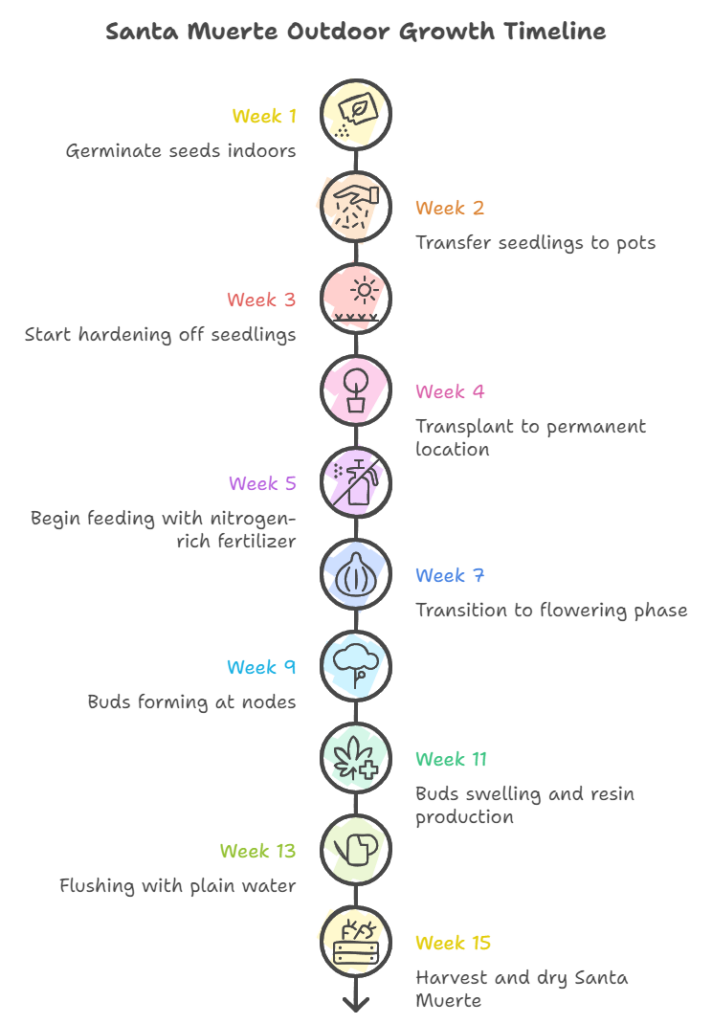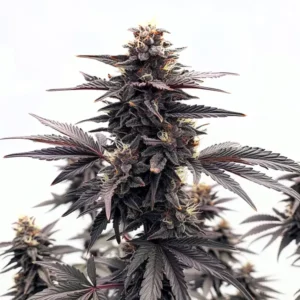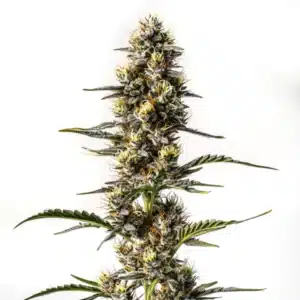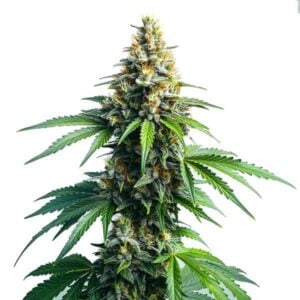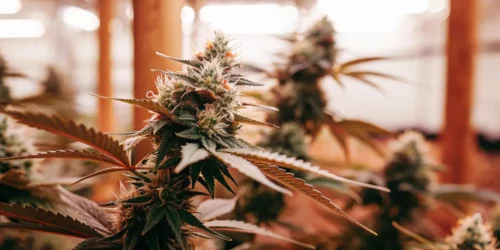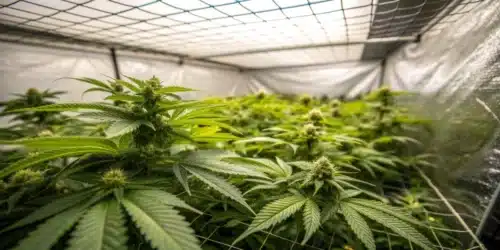Why Choose Santa Muerte?
Santa Muerte strain is a highly sought-after option known for its potent effects and robust growth. Its high THC content delivers a strong, uplifting high that many cannabis enthusiasts love. But what sets this strain apart is its resilience. The Santa Muerte strain thrives in outdoor conditions, making it an ideal choice for South American growers. When properly cultivated, this strain produces dense, resinous buds with a pungent aroma and intense flavor profile.
Santa Muerte is not only vigorous in growth but also resistant to many common pests and mold. This feature makes it a reliable option for outdoor growing, where weather conditions and pests can often become challenging. By choosing Santa Muerte, you’re opting for a strain that offers high yields, powerful effects, and relatively low maintenance, making the outdoor cultivation process both rewarding and manageable.
Recommended Strains
Santa Muerte
 THC: 18 - 20%
THC: 18 - 20% Type of seed: Feminized
Type of seed: Feminized Phenotype: Mostly Sativa
Phenotype: Mostly Sativa Day to flower: 10 - 12 weeks
Day to flower: 10 - 12 weeks
Santa Muerte FBV
 THC: 17 - 20%
THC: 17 - 20% Type of seed: Fast Flowering
Type of seed: Fast Flowering Phenotype: Mostly Sativa
Phenotype: Mostly Sativa Day to flower: 8 - 10 weeks
Day to flower: 8 - 10 weeks
Promos & Deals
Can You Grow Santa Muerte Outdoors in South America?
Absolutely! Growing Santa Muerte outdoors in South America can be highly rewarding, thanks to the continent’s diverse climate. South America provides a range of environments, from tropical rainforests to arid regions and temperate zones, allowing growers to tailor their methods to the specific conditions of their area. Santa Muerte adapts well to these varying climates, producing impressive yields when given the right care and attention.
The key to success lies in timing and planning. In the tropical regions, the warm temperatures and abundant sunlight provide an ideal growing environment. In the more temperate areas, starting your grow in spring allows the plants to take full advantage of the long daylight hours, resulting in robust vegetative growth before transitioning into the flowering phase. With proper care, growers across South America can expect a plentiful harvest of high-quality buds from Santa Muerte.
Geographic Considerations for Growing in South America
South America’s diverse geography plays a significant function in how you approach growing Santa Muerte outdoors. In the tropical regions, such as parts of Brazil and Colombia, the climate is warm and humid year-round. This environment encourages rapid growth but also poses challenges, such as the risk of mold and pests. In these regions, choosing a location with plenty of sunlight and good airflow is key to minimizing moisture buildup and preventing mold during the flowering stage.
More temperate areas, like Chile and Argentina, summers are warm, while winters can be cooler and wetter. In these regions, it’s best to start your grow in early spring to maximize the growing season. Choosing a spot that receives plenty of sunlight and has some protection from strong winds is key. Using greenhouses or simple covers helps protect the plants from unexpected weather changes, extending the growing season and ensuring a more controlled environment.
In drier, arid areas, such as parts of Peru and northern Argentina, water management becomes the main concern. Here, setting up an efficient watering system and mulching around the base of the plants to retain moisture is essential. By understanding the specific needs of your region, you can adapt your cultivation methods to ensure a successful grow when growing Santa Muerte outdoors in South America.
Outdoor Growing: Tropical, Temperate, and Arid Regions
Tropical Regions: Warm and Humid
In tropical regions of South America, such as Brazil and Colombia, the year-round warmth provides an excellent environment for growing the Santa Muerte strain outdoors. The extended daylight hours and consistent temperatures encourage fast and vigorous growth. However, high humidity also means a higher risk of mold and pests, particularly during the flowering phase. Choosing a location with plenty of sunlight and good airflow helps reduce these risks.
Watering plays an important role in the tropics. With frequent and heavy rainfall, it’s vital to use well-draining soil to prevent root rot. Raised garden beds or containers are effective in improving drainage. Regular pruning and spacing out plants improve airflow around the foliage, minimizing the risk of mold. Additionally, using natural pest repellents, such as neem oil, helps keep unwanted insects at bay without harming the plants.

Temperate Regions: Mild Summers and Cooler Winters
In temperate regions like Chile and Argentina, summers are milder, offering an ideal growing season for Santa Muerte. Start planting in early spring to take full advantage of the long days and moderate temperatures. Select a spot that receives at least 6-8 hours of direct sunlight daily, and use mulch around the base of the plants to retain soil moisture during drier spells.
Watering in temperate regions requires balance. During the early summer, water the plants deeply but allow the soil to dry slightly between sessions to avoid waterlogging. As temperatures drop toward the end of the growing season, reduce watering to prevent excess moisture around the roots. In regions prone to strong winds, consider using windbreaks or placing the plants near natural barriers for added protection. Following these practices helps ensure a robust and healthy harvest of Santa Muerte.
Soil Preparation for Growing Santa Muerte Outdoors in South America
Proper soil preparation is key for a successful grow. Santa Muerte thrives in well-draining, nutrient-rich soil that allows the roots to access water and nutrients efficiently. In tropical regions of South America, where the soil is often clay-heavy and can retain too much moisture, adding perlite or coarse sand to the mix improves drainage and prevents waterlogging. Incorporating organic matter, like compost or aged manure, enhances soil fertility, promoting vigorous growth.
In temperate regions, the soil might be more balanced but can still benefit from amendments. Testing the soil pH is essential; Santa Muerte prefers a slightly acidic to neutral pH range of 6.0 to 7.0. If the pH is too low, adding lime raises it, while adding sulfur lowers it if necessary. Incorporating organic fertilizers such as bone meal, fish emulsion, and worm castings into the soil before planting provides a slow-release source of nutrients throughout the grow cycle. By preparing the soil properly, you set a solid foundation for growing Santa Muerte strain outdoors and ensure the plants have access to all the nutrients they need.
In arid regions, soil tends to dry out quickly and lacks organic matter. To address this, mix in compost and coco coir to improve water retention and nutrient availability. Mulching around the base of the plants helps conserve moisture and keeps the roots cool during hot days. With careful soil preparation, you create an environment where Santa Muerte can flourish, leading to a healthy and productive grow.

Photoperiod: Maximizing Natural Light in South America
Santa Muerte is a photoperiod strain, which means its flowering phase is triggered by changes in daylight hours. In South America, the growing season typically begins in spring, as the days start to lengthen. Planting in early spring allows the plants to take advantage of the extended daylight, promoting vigorous vegetative growth before transitioning into flowering as the days shorten in late summer.
In tropical regions, the consistent daylight hours throughout the year provide a unique opportunity for growing Santa Muerte outdoors. Because the strain responds to a decrease in daylight to begin flowering, growers in these regions can control the timing of the flowering phase by artificially reducing the amount of light the plants receive daily using light deprivation techniques.
In temperate areas with a more distinct growing season, starting the grow in early spring maximizes the plants’ exposure to natural light, encouraging rapid development. As autumn approaches and daylight decreases, Santa Muerte will naturally enter the flowering phase, resulting in a robust harvest by early to mid-fall. Managing the photoperiod effectively is key to ensuring a successful harvest when growing Santa Muerte outdoors.
Nutrients for Growing Santa Muerte Outdoors in South America
Santa Muerte is a nutrient-demanding strain, especially during its vegetative phase. Providing the appropriate nutrients at each stage of growth to achieving a high yield. During the vegetative stage, focus on a feeding schedule rich in nitrogen, which supports strong leaf and stem growth. Organic options like compost tea, fish emulsion, and blood meal offer a balanced source of nitrogen without the risk of chemical buildup. Apply these nutrients in moderation, starting with a lower concentration and gradually increasing as the plant matures.
As the plants transition to the flowering stage, switch to a nutrient mix higher in phosphorus and potassium while reducing nitrogen levels. These nutrients promote bud development and resin production, enhancing the potency and flavor of the final product. Organic fertilizers such as bone meal, bat guano, and liquid kelp provide the essential nutrients needed during this stage. Regularly monitor the plants for signs of nutrient deficiencies, such as yellowing leaves or slow growth, and adjust the feeding schedule accordingly.
In tropical and temperate climates, rainfall can affect nutrient availability. Frequent rain in tropical areas may cause nutrient leaching, requiring additional supplementation to maintain optimal growth. In drier regions, use slow-release fertilizers or compost teas to provide a consistent supply of nutrients. Consistent nutrient management is vital for growing Santa Muerte outdoors successfully, leading to resinous, aromatic buds.

Week-by-Week Care for Santa Muerte Outdoors
Weeks 1-2: Germination and Early Seedling Stage
Begin by germinating your Santa Muerte seeds indoors in a warm, moist environment. Once they sprout, transfer them to small pots with a light, well-draining soil mix. Keep the soil consistently moist but not waterlogged. During the first week, place the seedlings in an area with indirect sunlight, gradually moving them to direct sunlight by the second week. This gradual exposure strengthens the plants and prepares them for the outdoor environment.
Weeks 3-4: Transition to Outdoor Growth
After the seedlings have developed their first set of true leaves, start hardening them off by placing them outside for a few hours each day, gradually increasing their exposure. By the end of week 4, they should be ready to transplant into their permanent outdoor location. Choose a spot that receives at least 6-8 hours of direct sunlight. Begin feeding with a mild nitrogen-rich fertilizer to support vigorous vegetative growth.
Weeks 5-6: Full Vegetative Growth
During these weeks, the plants focus on building a strong structure. Continue feeding with a nitrogen-rich nutrient mix to support the development of leaves and stems. Water the plants deeply but allow the soil to dry out slightly between waterings to prevent root rot. In tropical regions, frequent rainfall may reduce the need for watering, while in arid areas, regular watering becomes very important. Prune lower branches and excess foliage to improve airflow, reducing the risk of mold and pests as the plants grow larger.
Weeks 7-8: Transition to Flowering
As daylight hours decrease, Santa Muerte will begin to transition into the flowering phase. Adjust the nutrient regimen by reducing nitrogen and increasing phosphorus and potassium to encourage bud formation and resin production. In regions with high humidity, prune the lower branches to promote airflow around the buds, minimizing the risk of mold and mildew. During this stage, continue to monitor the plants for any signs of nutrient deficiencies, pests, or mold and take corrective actions as needed.
Weeks 9-10: Early Flowering and Bud Development
As Santa Muerte enters the early flowering phase, buds will start forming at the nodes. During these weeks, it’s important to continue using your bloom-specific nutrient mix, rich in phosphorus and potassium, to support bud development. Reduce nitrogen feeding to avoid excessive foliage growth, as this can divert energy away from bud production. Be mindful not to overfeed, as this can lead to nutrient burn and affect overall plant health.
In South America’s tropical regions, where humidity levels are high, take extra care to prevent mold and mildew. Prune excess foliage and lower branches to improve airflow around the plants, which helps reduce moisture buildup. In temperate regions, keep an eye on the weather and provide some protection, such as a canopy or simple greenhouse, to shield the plants from unexpected rainfall. Proper care during these weeks is vital for growing Santa Muerte outdoors and achieving dense, resin-rich buds.
Weeks 11-12: Mid-Flowering and Bud Swelling
During the mid-flowering phase, the buds will begin to swell and become covered in a sticky layer of resin. Continue your bloom nutrient regimen, but consider slightly reducing the nutrient concentration to avoid buildup, which can impact flavor and quality. At this stage, monitor the plants closely for signs of nutrient deficiencies, pests, or mold. In tropical climates, ensure ample spacing between plants to maintain airflow, further minimizing mold risks.
Watering remains critical during this period. In drier regions, such as northern Argentina, deep watering is necessary, allowing the soil to dry slightly between sessions to prevent root rot. In more humid areas, reduce watering frequency to avoid moisture accumulation around the roots. These practices help your plants focus their energy on producing potent, aromatic buds, leading to a bountiful harvest when growing Santa Muerte outdoors.
Weeks 13-14: Late Flowering and Flushing
As the plants move into the late flowering phase, you’ll notice the buds reaching their peak size and density. During this time, trichomes will become more prominent, changing from clear to a milky white color. This indicates that the plants are nearing peak potency. Now, it’s time to begin flushing the plants with plain water. Flushing helps clear out any excess nutrients from the soil, resulting in smoother, better-tasting buds.
In tropical regions where rain is frequent, natural flushing can occur due to rainfall. However, keep an eye on the soil moisture to avoid overwatering. For drier areas, like some parts of Peru, manually flush the plants by thoroughly watering them with plain water every few days. Continue monitoring the trichomes; when they turn from milky to a slight amber hue, your Santa Muerte is ready for harvest. Proper flushing is key to ensuring the quality of your final product.
Week 15: Harvesting Santa Muerte
It’s time to reap the rewards of your hard work! Harvest Santa Muerte on a dry, sunny day to prevent moisture from settling on the buds. Use sterilized scissors to cut the branches, taking care not to damage the resin-coated buds. Hang the branches upside down in a dark, well-ventilated space to dry for about 7-10 days, depending on the ambient humidity and temperature in your area.
Once the buds feel dry to the touch, trim them and place them in airtight containers for curing. Proper curing is essential to enhance the flavor, aroma, and potency of the buds. During the first week of curing, open the containers daily to release excess moisture, this process, known as “burping,” helps prevent mold and allows the buds to develop their full terpene profile. By following these steps, your efforts in growing Santa Muerte outdoors will result in a premium, high-quality harvest.
Maintaining Plant Health Throughout the Grow Cycle
Maintaining the health of your plants from seedling to harvest is critical for maximizing yield and potency. Santa Muerte has a natural resilience to many pests and molds, but proactive care can help you avoid potential issues. During the vegetative phase, inspect the plants for common pests, such as aphids, spider mites, and caterpillars. Use natural pest control methods, like neem oil or insecticidal soaps, to keep these intruders at bay without harming the plant.
In tropical regions, where high humidity can lead to mold and mildew during the flowering phase, it’s important to prune excess foliage and ensure adequate spacing between plants to improve airflow. In temperate regions, monitor weather conditions closely and be prepared to cover the plants during periods of heavy rain. Soil health is equally important; regularly test soil pH and nutrient levels to keep them within the optimal range, preventing nutrient deficiencies or imbalances that could affect growth.
By keeping a close eye on plant health throughout the grow cycle, you set yourself up for a successful harvest when growing Santa Muerte outdoors. Consistent monitoring and quick action against any signs of pests or diseases ensure a more robust and potent crop.
